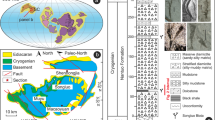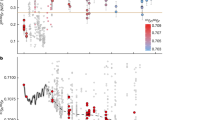Abstract
Recent re-evaluations of the geological record of the earliest life on Earth have led to the suggestion that some of the oldest putative microfossils1 and carbonaceous matter were formed through abiotic hydrothermal processes2,3. Similarly, many early Archaean (more than 3,400-Myr-old) cherts have been reinterpreted as hydrothermal deposits rather than products of normal marine sedimentary processes2,4,5. Here we present the results of a field, petrographic and geochemical study testing these hypotheses for the 3,416-Myr-old Buck Reef Chert, South Africa. From sedimentary structures and distributions of sand and mud, we infer that deposition occurred in normal open shallow to deep marine environments. The siderite enrichment that we observe in deep-water sediments is consistent with a stratified early ocean6,7. We show that most carbonaceous matter was formed by photosynthetic mats within the euphotic zone and distributed as detrital matter by waves and currents to surrounding environments. We find no evidence that hydrothermal processes had any direct role in the deposition of either the carbonaceous matter or the enclosing sediments. Instead, we conclude that photosynthetic organisms had evolved and were living in a stratified ocean supersaturated in dissolved silica8,9 3,416 Myr ago.
This is a preview of subscription content, access via your institution
Access options
Subscribe to this journal
Receive 51 print issues and online access
$199.00 per year
only $3.90 per issue
Buy this article
- Purchase on Springer Link
- Instant access to full article PDF
Prices may be subject to local taxes which are calculated during checkout




Similar content being viewed by others
References
Schopf, J. W. & Packer, B. M. Early Archean (3.3 billion to 3.5 billion-year-old) microfossils from Warrawoona Group, Australia. Science 237, 70–73 (1987)
Brasier, M. D. et al. Questioning the evidence for Earth's oldest fossils. Nature 416, 76–81 (2002)
Garcia-Ruiz, J. M. et al. Self-assembled silica-carbonate structures and detection of ancient microfossils. Science 302, 1194–1197 (2003)
Westall, F. et al. Early Archean fossil bacteria and biofilms in hydrothermally-influenced sediments from the Barberton greenstone belt, South Africa. Precambr. Res. 106, 93–116 (2001)
Paris, I., Stanistreet, I. G. & Hughes, M. J. Cherts of the Barberton greenstone belt as products of submarine exhalative activity. J. Geol. 93, 111–129 (1985)
Klein, C. & Beukes, N. J. Geochemistry and sedimentology of a facies transition from limstone to iron-formation deposition in the early Proterozoic Transvaal Supergroup, South Africa. Econ. Geol. 84, 1733–1774 (1989)
Lowe, D. R. in Early Life on Earth. Nobel Symposium No. 84 (ed. Bengston, S.) 24–35 (Columbia Univ. Press, New York, 1994)
Lowe, D. R. in Geologic Evolution of the Barberton Greenstone Belt, South Africa (eds Lowe, D. R. & Byerly, G. R.) 83–114 (Geol. Soc. Am. Spec. Pap. 329, Boulder, Colorado, 1999)
Siever, R. The silica cycle in the Precambrian. Geochim. Cosmochim. Acta 56, 3265–3272 (1992)
Lowe, D. R. & Byerly, G. R. in Geologic Evolution of the Barberton Greenstone Belt, South Africa (eds Lowe, D. R. & Byerly, G. R.) 1–36 (Geol. Soc. Am. Spec. Pap. 329, Boulder, Colorado, 1999)
Lowe, D. R. & Fisher Worrell, G. in Geologic Evolution of the Barberton Greenstone Belt, South Africa (eds Lowe, D. R. & Byerly, G. R.) 167–188 (Geol. Soc. Am. Spec. Pap. 329, Boulder, Colorado, 1999)
Tice, M. M., Bostick, B. C. & Lowe, D. R. Thermal history of the 3.5–3.2 Ga Onverwacht and Fig Tree Groups, Barberton greenstone belt, South Africa. Geology 32, 37–40 (2004)
Sumner, D. Y. Late Archean calcite–microbe interactions: Two morphologically distinct microbial communities that affected calcite nucleation differently. Palaios 12, 302–318 (1997)
Walsh, M. M. & Lowe, D. R. in Geologic Evolution of the Barberton Greenstone Belt, South Africa (eds Lowe, D. R. & Byerly, G. R.) 115–132 (Geol. Soc. Am. Spec. Pap. 329, Boulder, Colorado, 1999)
Simonson, B. M., Schubel, K. A. & Hassler, S. W. Carbonate sedimentology of the early Precambrian Hamersley Group of Western Australia. Precambr. Res. 60, 287–335 (1993)
Lowe, D. R. & Byerly, G. R. Ironstone pods in the Archean Barberton greenstone belt, South Africa: Earth's oldest seafloor hydrothermal vents reinterpreted as Quaternary subaerial springs. Geology 31, 909–912 (2003)
de Wit, M. J., Hart, R., Martin, A. & Abbott, P. Archean abiogenic and probable biogenic structures associated with mineralized hydrothermal vent systems and regional metasomatism, with implications for greenstone belt studies. Econ. Geol. 77, 1783–1802 (1982)
Knauth, L. P. & Lowe, D. R. High Archean climatic temperature inferred from oxygen isotope geochemistry of cherts in the 3.5 Ga Swaziland Supergroup, South Africa. Geol. Soc. Am. Bull. 115, 566–580 (2003)
Horita, J. & Berndt, M. E. Abiogenic methane formation and isotopic fractionation under hydrothermal conditions. Science 285, 1055–1057 (1999)
Schidlowski, M. in Microbial Sediments (eds Riding, R. E. & Awramik, S. M.) 84–95 (Springer, New York, 2000)
Madigan, M. T., Martinko, J. M. & Parker, J. Brock Biology of Microorganisms (Prentice-Hall, Upper Saddle River, New Jersey, 1997)
Boggs, S. Principles of Sedimentology and Stratigraphy (Prentice-Hall, Englewood Cliffs, New Jersey, 1995)
Lalli, C. M. & Parsons, T. R. Biological Oceanography: An Introduction (Butterworth-Heinemann, Boston, 1997)
Acknowledgements
This work was supported by NASA Exobiology Program grants to D.L. M.T. was also supported by a William R. and Sara Hart Kimball Stanford Graduate Fellowship and by a Harvey Fellowship.
Author information
Authors and Affiliations
Corresponding author
Ethics declarations
Competing interests
The authors declare that they have no competing financial interests.
Rights and permissions
About this article
Cite this article
Tice, M., Lowe, D. Photosynthetic microbial mats in the 3,416-Myr-old ocean. Nature 431, 549–552 (2004). https://doi.org/10.1038/nature02888
Received:
Accepted:
Issue Date:
DOI: https://doi.org/10.1038/nature02888
This article is cited by
-
Comparative analysis of reconstructed ancestral proteins with their extant counterparts suggests primitive life had an alkaline habitat
Scientific Reports (2024)
-
Emerging roles for diguanylate cyclase during the evolution of soma in dictyostelia
BMC Ecology and Evolution (2023)
-
A Metagenomic Time-Series Approach to Assess the Ecological Stability of Microbial Mats in a Seasonally Fluctuating Environment
Microbial Ecology (2023)
Comments
By submitting a comment you agree to abide by our Terms and Community Guidelines. If you find something abusive or that does not comply with our terms or guidelines please flag it as inappropriate.



